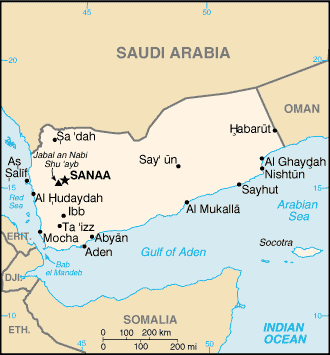Map:

Overview:
North Yemen became independent of the Ottoman Empire in 1918. The British, who had set up a protectorate area around the southern port of Aden in the 19th century, withdrew in 1967 from what became South Yemen. Three years later, the southern government adopted a Marxist orientation. The massive exodus of hundreds of thousands of Yemenis from the south to the north contributed to two decades of hostility between the states. The two countries were formally unified as the Republic of Yemen in 1990. A southern secessionist movement in 1994 was quickly subdued. In 2000, Saudi Arabia and Yemen agreed to a delimitation of their border.
The People:
Population: 20,727,063 (July 2005 est.)
Age structure:
0-14 years: 46.5% (male 4,905,831/female 4,727,177)
15-64 years: 50.8% (male 5,364,711/female 5,172,811)
65 years and over: 2.7% (male 274,166/female 282,367) (2005 est.)
Median age: total: 16.54 years
male: 16.53 years
female: 16.56 years (2005 est.)
Religions:
Muslim including Shaf'i (Sunni) and Zaydi (Shi'a), small numbers of Jewish, Christian, and Hindu
Government Type:
republic
Leader(s) to pray for:
chief of state: President Ali Abdallah SALIH (since 22 May 1990, the former president of North Yemen, assumed office upon the merger of North and South Yemen); Vice President Maj. Gen. Abd al-Rab Mansur al-HADI (since 3 October 1994)
head of government: Prime Minister Abd al-Qadir BA JAMAL (since 4 April 2001)
Source: The World Factbook
View All Countries